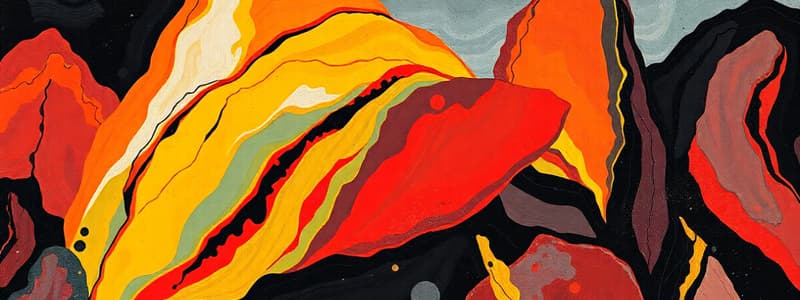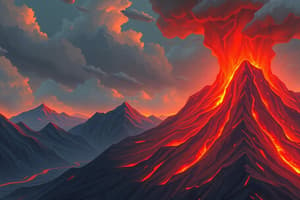Podcast
Questions and Answers
What is one possible outcome when felsic magma rises?
What is one possible outcome when felsic magma rises?
- It may cool into a granitic batholith. (correct)
- It tends to dissolve into the mantle.
- It can completely solidify into a basalt layer.
- It will always lead to the formation of a mafic volcano.
What is the primary reason for the generation of magma at subduction zones?
What is the primary reason for the generation of magma at subduction zones?
- The release of water from hydrated minerals (correct)
- The rising temperature of the mantle
- The addition of water from surface sources
- The melting of the tectonic plates
What characterizes intraplate volcanism related to a hotspot?
What characterizes intraplate volcanism related to a hotspot?
- It forms chains of extinct volcanoes connected to eruption zones. (correct)
- It is only confined to oceanic plates.
- It is solely dependent on tectonic plate boundaries.
- It typically forms parallel volcanic chains.
What type of magma is primarily produced from subduction-related volcanism?
What type of magma is primarily produced from subduction-related volcanism?
Which statement accurately describes the Hawaiian Islands in relation to hotspot volcanism?
Which statement accurately describes the Hawaiian Islands in relation to hotspot volcanism?
Which geological feature is most commonly associated with subduction volcanism?
Which geological feature is most commonly associated with subduction volcanism?
What process contributed to the formation of the Yellowstone caldera?
What process contributed to the formation of the Yellowstone caldera?
At continental rifts, what leads to volcanic activity?
At continental rifts, what leads to volcanic activity?
Which of the following describes the geological significance of the Emperor Seamounts?
Which of the following describes the geological significance of the Emperor Seamounts?
In the context of volcanism, what characteristic of magma produced at continental rifts differs from that at subduction zones?
In the context of volcanism, what characteristic of magma produced at continental rifts differs from that at subduction zones?
What is the primary cause of cinder cone eruptions in the Black Rock Desert?
What is the primary cause of cinder cone eruptions in the Black Rock Desert?
How long ago did the most recent eruption of the cinder cones in Utah occur?
How long ago did the most recent eruption of the cinder cones in Utah occur?
What defines a hotspot in the context of intraplate volcanism?
What defines a hotspot in the context of intraplate volcanism?
What typically happens when ascending magma from a mantle plume reaches the lithospheric crust?
What typically happens when ascending magma from a mantle plume reaches the lithospheric crust?
Why do most mantle plumes mainly occur beneath oceanic lithosphere?
Why do most mantle plumes mainly occur beneath oceanic lithosphere?
Flashcards
Subduction Zones
Subduction Zones
Convergent plate boundaries where one tectonic plate slides beneath another, causing volcanic activity.
Flux Melting
Flux Melting
Melting of rock caused by the addition of water from a descending plate at a subduction zone.
Volcanic Arc
Volcanic Arc
A chain of volcanoes formed above a subduction zone.
Continental Rifts
Continental Rifts
Signup and view all the flashcards
Decompression Melting
Decompression Melting
Signup and view all the flashcards
Basaltic cinder cones
Basaltic cinder cones
Signup and view all the flashcards
Hotspots
Hotspots
Signup and view all the flashcards
Mantle plume
Mantle plume
Signup and view all the flashcards
Intraplate volcanism
Intraplate volcanism
Signup and view all the flashcards
Basin and Range Province
Basin and Range Province
Signup and view all the flashcards
Hotspot Volcanism
Hotspot Volcanism
Signup and view all the flashcards
Intraplate Volcanism
Intraplate Volcanism
Signup and view all the flashcards
Mantle Plume
Mantle Plume
Signup and view all the flashcards
Volcanic Chain
Volcanic Chain
Signup and view all the flashcards
Yellowstone Caldera
Yellowstone Caldera
Signup and view all the flashcards
Study Notes
Igneous Processes and Volcanoes
-
Bowen's Reaction Series: Key relationship between minerals and temperature in igneous rocks. Certain minerals always form together and exclude others, depending on cooling temperature. Bowen's experiments showed this. Mafic minerals crystallize at higher temperatures than felsic minerals.
-
Magma Generation: Magma comprises melt, solids, and volatiles. Melt is minerals that liquefied; solids are crystallized minerals in the melt; volatiles include water vapor, carbon dioxide, sulfur, and chlorine. These components influence magma's behavior.
-
Geothermal Gradient: Earth's temperature increases with depth. The average geothermal gradient in the upper 100 km of the crust is 25°C per kilometer of depth. The temperature at any depth depends on pressure. Higher pressure increases the melting temperature of rocks.
-
Volcanism: Molten rock (lava) reaching Earth's surface. Volcanoes form where lava solidifies. Volcanoes are categorized based on location (interplate or intraplate), type, hazards, and monitoring.
-
Interplate Volcanoes: Located at active plate boundaries (mid-ocean ridges, subduction zones, and continental rifts). These include most mid-ocean ridge volcanoes, with basalt being the most common type of rock.
-
Intraplate Volcanoes: Located within tectonic plates, away from plate boundaries. Many are associated with hotspots. Hotspots are stationary sources of magma in the mantle.
-
Volcano Features and Types: Volcanoes vary in shape, eruption style, and composition. Different types include shield volcanoes, stratovolcanoes, cinder cones, and calderas.
-
Volcanic Hazards: Lava flows, pyroclastic flows (hot gas and rock), lahars (volcanic mudflows), landslides, and volcanic gases.
-
Volcanic Monitoring: Techniques used to predict eruptions, such as analysis of earthquake activity, gas emissions, and ground deformation.
Studying That Suits You
Use AI to generate personalized quizzes and flashcards to suit your learning preferences.




